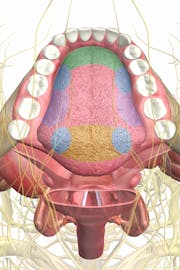Tongue and Taste

The tongue is made up of muscles covered by mucous membranes. These muscles are attached to the lower jaw and to the hyoid bone, which is located just above the larynx and anchors the muscles of the tongue (it is the only bone in the body that doesn't touch any other bone). The muscle fibers are heavily supplied with nerves, so it can manipulate food in the mouth and place it between the teeth for chewing - without being bitten in the process. The tongue also aids in the formation of sounds of speech and coordinates its movements to aid in swallowing.
On the surface of the tongue are special areas that detect the flavor of food. These begin with very small nodules, called papillae, that form the top surface of the tongue and give it its rough texture. Between the papillae at the sides and base of the tongue are small, bulblike structures that are sensory organs, called taste buds, which enable us to enjoy the sensations of flavor and warn us when food is unfit to eat.
There are four types of these taste receptors: (1) sweet, as produced by table sugar; (2) sour, as produced by vinegar; (3) salty, as produced by table salt; and (4) bitter, as produced by caffeine or quinine. Each of these taste receptors is most highly concentrated in certain regions of the tongue's surface. Sweet receptors are mostly on the tip of the tongue (noted in a child's preference to lick a candy sucker rather than chew it). Sour receptors occur primarily along the sides of the tongue and are stimulated mainly by acids. Salt receptors are most common in the tip and upper front portion of the tongue. They are stimulated mainly by inorganic salts. Bitter receptors are located toward the back of the tongue. They are stimulated by a variety of chemical substances, most of which are organic compounds, although some inorganic salts of magnesium and calcium produce bitter sensations too.
Babies have many more of these taste buds than an adult, and they have these almost everywhere in the mouth, including the cheeks. Perhaps it is for this reason that adults enjoy more flavors than babies, who dislike bitter tastes and prefer bland food. The average adult has about 9,000 taste buds on each surface of the tongue, roof of the mouth, and throat.


